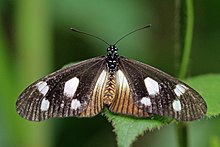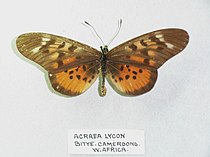Acraea lycoa
| Lycoa acraea | |
|---|---|

| |

| |
| Female imagos of the race A. lycoa entebbia from Kibale Forest, Uganda | |
| Scientific classification | |
| Domain: | Eukaryota |
| Kingdom: | Animalia |
| Phylum: | Arthropoda |
| Class: | Insecta |
| Order: | Lepidoptera |
| Family: | Nymphalidae |
| Genus: | Acraea |
| Species: | A. lycoa
|
| Binomial name | |
| Acraea lycoa | |
| Synonyms | |
| |
Acraea lycoa, the lycoa acraea, is a butterfly in the family Nymphalidae which is native to the African tropics and subtropics.
Region[edit]
It is found in Sierra Leone, Liberia, Ivory Coast, Ghana, Togo, Benin, Nigeria, Cameroon, Bioko, Angola, the Democratic Republic of the Congo, Sudan, Uganda, Rwanda, Burundi, Ethiopia, Kenya, Tanzania and Zambia.[3]
Description[edit]
A. lycoa is a very variable species nearly allied to johnstoni; it differs from this in having the light basal or median area of the hindwing distally rounded or occasionally entirely absent. The fore wing has normally 5-7 white or whitish spots, in the male sometimes dull and very indistinct; the first is placed in 1b close to the distal margin and is quite free and rounded or partly joined to the spot in 2, but never extends so far basad as the latter; the third is placed in 4 near to the distal margin quite free or touching the spot in 5; the spots in 5 and 6 are of equal length, joined to one another and to small spots in cellules 8 and 9; the cell always unicolorous without spots.
- lycoa Godt. both wings thinly scaled, semi-transparent; spots of the forewing indistinct; basal area of the hindwing large, dull reddish yellow, distally rather sharply defined against the grey marginal band. female: wings thinly scaled, dark grey with distinct white markings; marginal band media, of the hindwing broad, not sharply defined. Sierra Leone to Nigeria.
- media Eltr. (57 a, as lycoa). male. Spots of the forewing more distinct; hindwing in the middle somewhat tinged with reddish yellow but without distinct basal area. female with darker ground-colour and sharply defined marginal band on the hindwing. Cameroons to Toro.
- bukoba Eltr. male Forewing dark olive-brown; spots light yellow, sharply defined; basal area of the hindwing ochre-yellow. female similar to the male, but darker, with white or whitish markings. The spot in 1b of the forewing in both sexes entirely free and broadly separated from the spot in 2. Urundi.
- entebbia Eltr. The spot in 1b of the forewing quite free; ground-colour in the male yellowish grey; spots of the forewing small, dull yellowish; basal area of the hind wing small, not reaching the inner margin; ground-colour in the female very dark, spots of the forewing white, basal area of the hindwing whitish yellow. Uganda.
- tirika Eltr. Spot 1b of the forewing widely separated; ground-colour of the fore wing in the olive-brown, in the female very dark, spots small; basal area of the hind wing yellowish. British East Africa.
- fallax Rogenh. (57 c). Ground-colour in both sexes nearly black; spots of the forewing small, in the male yellowish, in the female white, spot 1b widely separated from spot 2; basal area of the hindwing sharply defined, yellowish. German East Africa: Kilimandjaro.
- kenia Eltr. Smaller than the other races; ground-colour nearly black; spots of the forewing in the male lemon-yellow, in the female white; basal area of the hindwing in both sexes lemon-yellow. British East Africa: Kenia; Kikuyu.
- aequalis Rothsch. and Jord. Sexes similar; spots of the forewing and basal area of the hindwing dull yellowish; marginal band of the hindwing yellowish dark brown. Abyssinia.[4]
Biology[edit]
The habitat consists of forests.
The larvae feed on Theobroma cacao, Pouzolzia guineensis, Pouzolzia parasitica, Aneilema and Fleurya species.
Taxonomy[edit]
It is a member of the Acraea jodutta species group – but see also Pierre & Bernaud, 2014 [5]
References[edit]
- ^ Godart J.-B. in Latreille, P. A., & Godart, J.-B. [1819] Encyclopedie Methodique Histoire Naturelle [Zoologie] 9 Entomologie: i-iv, 1-328
- ^ "Acraea Fabricius, 1807" at Markku Savela's Lepidoptera and Some Other Life Forms
- ^ "Afrotropical Butterflies: Nymphalidae - Tribe Acraeini". Archived from the original on 2012-08-10. Retrieved 2012-06-05.
- ^ Aurivillius, [P. O.] C. 1908-1924. In: Seitz, A. Die Großschmetterlinge der Erde Band 13: Abt. 2, Die exotischen Großschmetterlinge, Die afrikanischen Tagfalter, 1925, 613 Seiten, 80 Tafeln (The Macrolepidoptera of the World 13). Alfred Kernen Verlag, Stuttgart.
 This article incorporates text from this source, which is in the public domain.
This article incorporates text from this source, which is in the public domain.
- ^ Pierre & Bernau, 2014 Classification et Liste Synonymique des Taxons du Genre Acraea pdf
External links[edit]
- Die Gross-Schmetterlinge der Erde 13: Die Afrikanischen Tagfalter. Plate XIII 57 c and also c as fallax
- Images representing Acraea lycoa at Bold.
- Acraea lycoa lycoa Archived 2020-01-27 at the Wayback Machine at Pteron


